Big “Chip Off A Popular Block” – Trans Canada Airlines New Vickers Vanguard
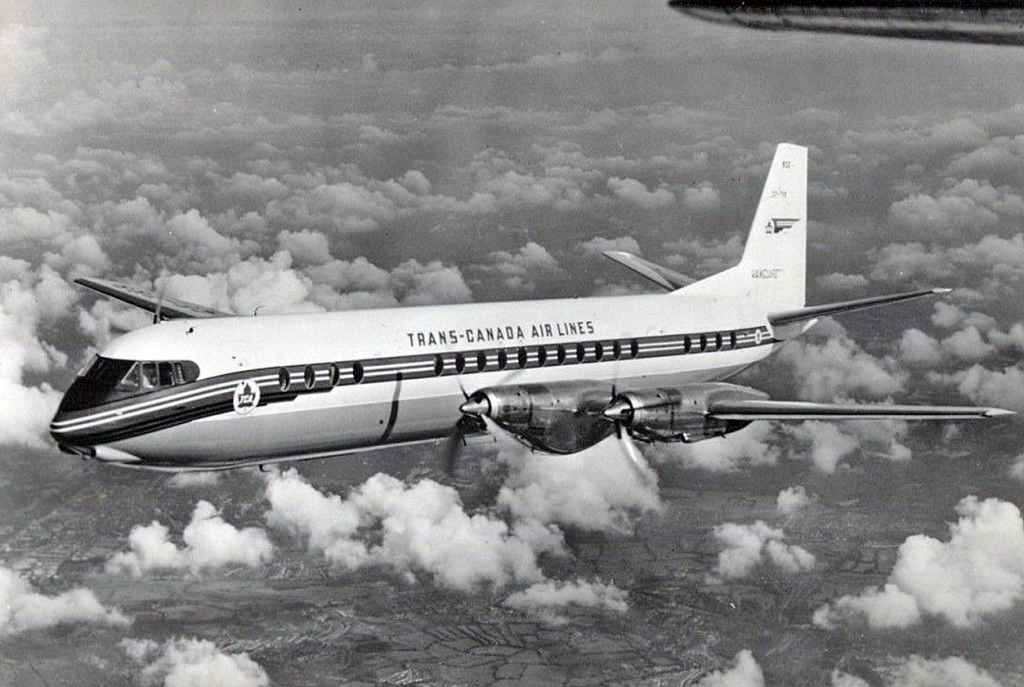
TCA Vanguard inflight circa 1960 over the UK countryside on a test flight from Weybridge, prior to delivery to Trans Canada Air Lines.
(CLICK HERE for Air Canada Vanguard retirement report October 31, 1971)
The following article appeared in the June 1959 issue of In Flight, by Trans Canada Air Lines
The small boy in the back row of the schoolroom, carefully folding a page from his scribbler into a paper airplane, may be following in his father’s footsteps. At that very moment, in fact, his airline engineer father may be working with a paper plane too. But the parallel ends with the word “paper.” The small boy’s plane is a simple experiment in basic aerodynamics, whereas the father’s is an intricate statistical exercise in airline economics, and a major factor in planning for years ahead.
Flying paper airliners from point-to-point is an everyday activity at Trans-Canada Air Lines’ Montreal headquarters. Seven years ago, TCA began an intensive all-departments study of available and drawing-board airliners in the short, medium and long-range turbo-prop and pure jet classes, to determine their potential for TCA routes. Out of this seven-year study came TCA orders for the world’s first and most successful turbo-prop airliner, the Vickers Viscount; the magnificent long-range DC-8 jetliner (to be delivered early 1960), and for the huge Vickers Vanguard turbo-prop for medium-range routes and southern services.
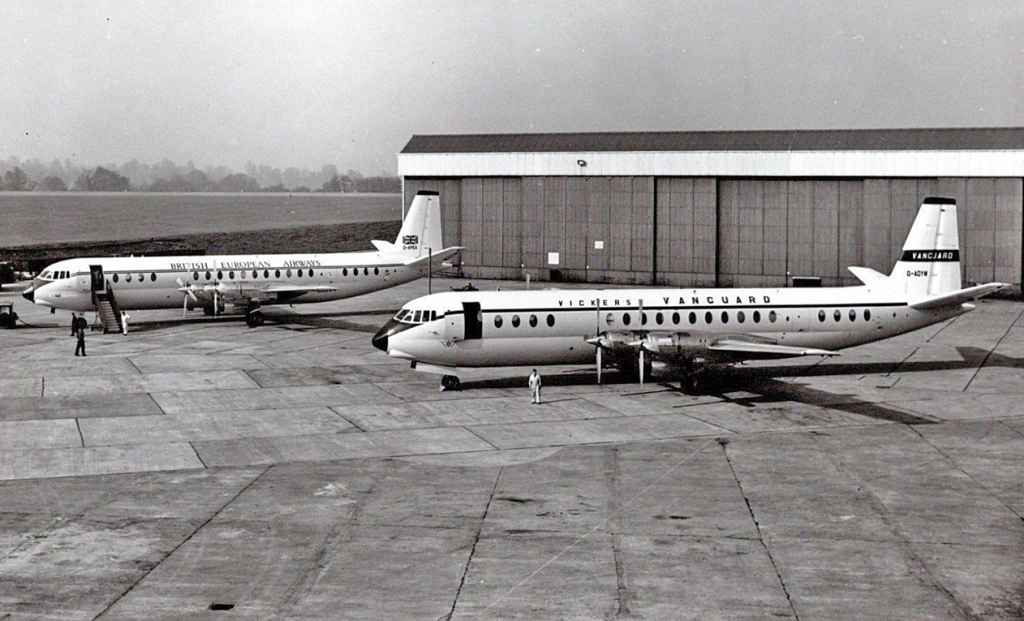
First built Vickers Vanguards G-AOYW and G-APEA at Weybridge circa 1959-1960.

This is the tentative Trans Canada Vickers Vanguard cabin configuration with only 96 seats, versus the maximum 139 seats high density configuration.
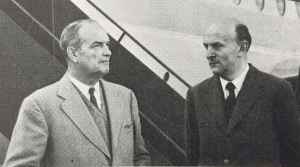
TCA President, Gordon McGregor, left, and Sir George Edwards, head of Vickers-Amstrong (Aircraft) Ltd., chat following a test flight in the brand new Vickers Vanguard.
Built-in economy and flexibility, wedded to Rolls-Royce turbo-prop reliability and smoothness, put the Vanguard far out in front of its closest competitors. It will operate out of existing runways at most airports, and presents no noise problem. One of its most interesting features is its ‘double-bubble’ fuselage and the exciting potential of this engineering approach.
In most airliners, the tube fuselage concept means that freight holds must be located in the small under-floor section, which has no real floor area, or on the floor level, with passengers. More freight can be accommodated only by removing passenger seats and closing off a freight area. But in the Vanguard, two huge freight holds occupy the lower ‘bubble,’ leaving the main floor exclusively for passengers. On full passenger service during peak travel hours, the Vanguard can switch to an all-freight schedule when early morning hours cut down passenger loads, thus maintaining high utilization at low operating costs.
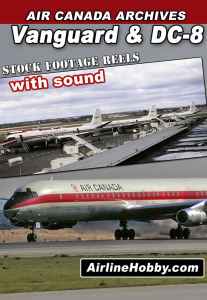 The Vickers design team, led by Sir George Edwards, who was knighted in 1957 for his contribution to British and world aviation, have developed an airframe of almost unlimited application on most world air routes. Working with Rolls-Royce, pioneers in the gas turbine field, Vickers chose the new high-compression Tyne, an engine with a weight-to-power ratio 37% higher than the wonderfully successful Dart, yet delivering 3.2 times more power at 40% less specific fuel consumption. TCA’s own Engineering Department made important contributions to the mutual effort of Vickers and Rolls-Royce to set a new standard in the turbo-prop class.
The Vickers design team, led by Sir George Edwards, who was knighted in 1957 for his contribution to British and world aviation, have developed an airframe of almost unlimited application on most world air routes. Working with Rolls-Royce, pioneers in the gas turbine field, Vickers chose the new high-compression Tyne, an engine with a weight-to-power ratio 37% higher than the wonderfully successful Dart, yet delivering 3.2 times more power at 40% less specific fuel consumption. TCA’s own Engineering Department made important contributions to the mutual effort of Vickers and Rolls-Royce to set a new standard in the turbo-prop class.
For the TCA passenger, the big Vanguard will bring such innovations as twin-door boarding on self contained air stairs, which retract into the aircraft. The popular deep oval Viscount-type Windows (40 in the Vanguard, compared to 20 in the Viscount) extend well ahead of the wing. TCA’s tentative 96-seat configuration (see diagram) in an aircraft which will take 139 seats, is extra-spacious.
First of 20 TCA Vanguards will be delivered in late 1960 or early 1961. Shortly after the Vanguards enter service, TCA will become the first intercontinental airline in the world to operate an all-turbine fleet. And there is no doubt that without the “paper” airliners that fly their invisible routes in planning and development offices, the transition from piston to turbine would be much longer in coming, and not quite so well tailored to demanding Canadian requirements.
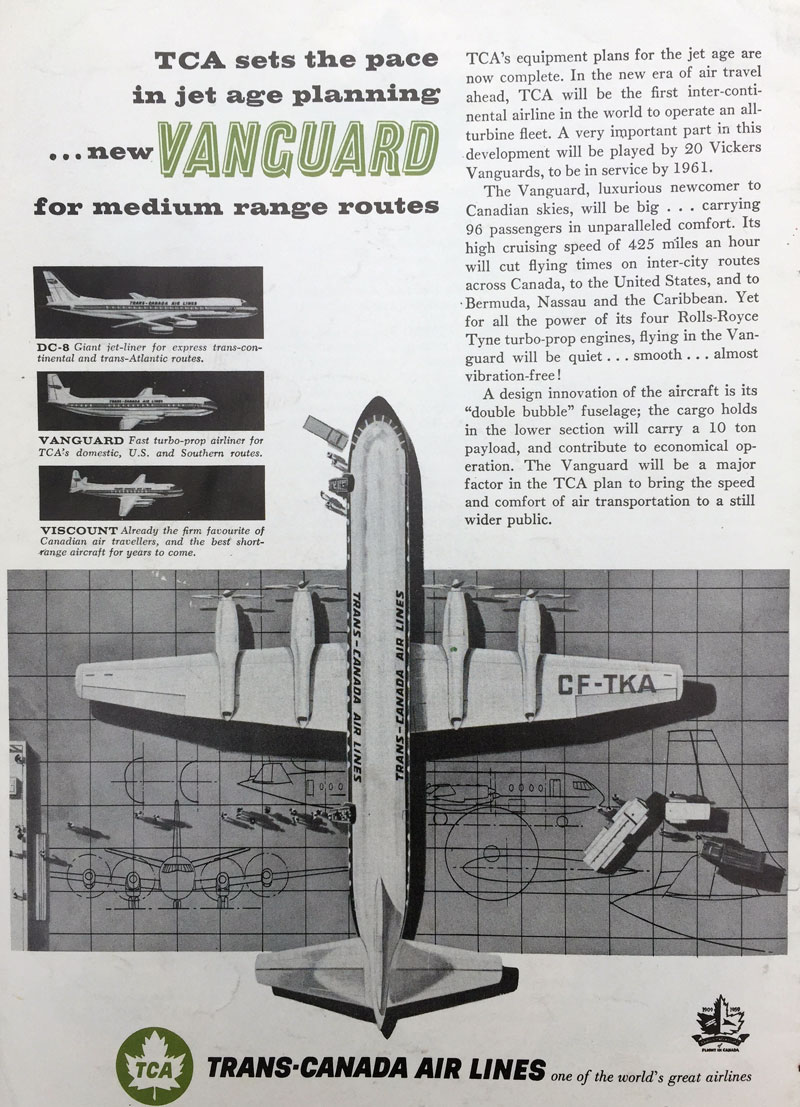
TCA Vanguard advert June 1959, boasting “TCA’s equipment plans for the jet age are now complete. In the new era of air travel ahead, TCA will be the first inter-continental airline in the world to operate an all-turbine fleet.” TCA had a standing order for 20 Vickers Vanguards to be inservice by 1961.
Tags: Trans-Canada, Vanguard, Vickers

No comments yet.